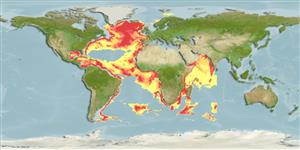Actinopterygii (ray-finned fishes) >
Gadiformes (Cods) >
Macrouridae (Grenadiers or rattails) > Macrourinae
Etymology: Coryphaenoides: Greek, koryphaina = dolphin fish + Suffix oides = similar to (Ref. 45335). More on author: Goode, Bean.
Environment / Climate / Range
Ecology
Marine; bathydemersal; depth range 384 - 5610 m (Ref. 11953). Deep-water, preferred ?
Atlantic Ocean: both sides of the North Atlantic and from the southeast Atlantic. Also known from the southern Indian Ocean.
Length at first maturity / Size / Weight / Age
Maturity: Lm ?, range 17 - ? cm
Max length : 45.0 cm TL male/unsexed; (Ref. 26340)
Narrow band of pointed teeth in the premaxillae. Head scaled except for gular and branchiostegal membranes. Body scales either plain or armed with slightly divergent rows of small spinules (Ref. 37108).
Bathypelagic (Ref. 58426). Feeds on polychaete worms, copepods, amphipods, isopods and mysids (Ref. 6187). Minimum depth from Ref. 58018.
Life cycle and mating behavior
Maturity | Reproduction | Spawning | Eggs | Fecundity | Larvae
Iwamoto, T. and E. Anderson, 1994. Review of the grenadiers (Teleostei: Gadiformes) of southern Africa, with descriptions of four new species. Ichthyol. Bull. J.L.B. Smith Inst. Ichthyol. (61):1-28. (Ref. 11953)
IUCN Red List Status (Ref. 115185)
CITES (Ref. 94142)
Not Evaluated
Threat to humans
Harmless
Human uses
Tools
Special reports
Download XML
Internet sources
